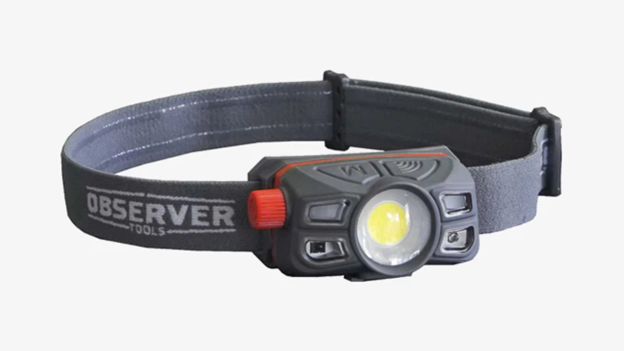Are you a frequent traveler? If yes, a headlamp is important when enjoying outdoor activities such as camping, hiking, etc. That’s when a high-lumen Headlamp comes into the picture. It offers reliable, hands-free lighting, making it easy to pass through dark trails, set up tents or work on projects after sunsets.
However, to maintain your headlamp’s longevity, it is essential to care for it properly. But if you still don’t know how to take care of headlamps, here are simple tips to ensure they stay bright, durable, and ready whenever needed.
1. Regular Cleaning and Maintenance
Dirt, dust, and grime can build up on your headlamp, affecting its brightness and functionality.
- Clean the Lens: A clean lens is essential for clear light output. Use a soft, dry cloth to wipe away any dust or smudges. For more stubborn dirt, dampen the cloth slightly, but avoid using harsh chemicals, as these can damage the lens coating.
- Body Cleaning: Gently clean the headlamp’s body and strap. If the headlamp is particularly dirty, you can use a mild soap solution but do not submerge it completely in water unless it’s rated for full waterproofing.
- Check and Clean the Sensors: If your headlamp has a motion sensor or other advanced features, keeping these sensors clean ensures they operate correctly. A quick wipe with a cloth is usually enough to keep sensors clear.
2. Battery Care and Charging Tips
Most modern headlamps are rechargeable, eco-friendly and cost-effective compared to disposable batteries.
- Charge Regularly: Rechargeable headlamps should be charged when they reach around 20% battery life rather than letting them fully deplete. This helps to preserve battery health over time.
- Avoid Overcharging: Overcharging can reduce the battery’s overall lifespan. Once the headlamp reaches full charge, unplug it from the charger to prevent strain on the battery.
- Store Properly: If you won’t use the headlamp for an extended period, charge it to about 50% and store it in a cool, dry place. This prevents battery drain and helps maintain its charge-holding ability.
3. Protect Against Environmental Exposure
Headlamps are often exposed to challenging conditions, so it’s essential to take steps to protect them from environmental wear and tear.
- Temperature Control: Extreme temperatures can affect battery life and the functionality of your headlamp. Most headlamps have an optimal operating range; avoid leaving them in very hot or cold environments when not used.
- Water and Dust Resistance: Many headlamps have an IP (Ingress Protection) rating indicating their resistance to water and dust. Familiarize yourself with your headlamp’s rating and do not exceed its capabilities. For instance, led headlamp are protected against dust and can handle submersion up to a certain depth, but they aren’t meant for prolonged underwater exposure.
- Impact Protection: Just because your headlamp is drop-resistant doesn’t mean it’s indestructible. Avoid hard impacts or drops whenever possible, as these can loosen internal components over time.
4. Use Light Modes Wisely
Many headlamps feature adjustable brightness settings to suit different needs. Proper use of these settings can conserve battery life and improve your headlamp’s longevity.
- Use High Beam Sparingly: High beam settings provide maximum brightness but drain the battery faster. Save the high beam for maximum visibility over long distances or for a short-term task.
- Low and Medium Modes for Routine Use: For activities like reading, walking on trails, or general lighting, medium or low settings provide adequate illumination without unnecessary battery drain.
- Strobe or SOS Mode: Some headlamps have strobe or SOS functions for emergencies. These modes are useful for attracting attention but should be used sparingly, as they may consume more power.
5. Maintain a Secure and Comfortable Fit
A comfortable and secure headlamp is essential for extended wear, whether hiking, camping, or working in low light.
- Adjust the Strap Regularly: The headlamp strap may lose elasticity or become misaligned over time. Adjust it as needed for a snug but comfortable fit.
- Check for Slip-Resistant Features: Some headlamps come with silicon strips or clips for hardhats. These help keep the headlamp secure on your head or helmet. Make sure they’re in place and functioning well, especially if you’re working in active environments.
6. Take Advantage of Special Features
Some headlamps have features like motion sensors or variable intensity dials that enhance their functionality. Proper use of these features can make your headlamp even more efficient.
- Use Motion Sensors Carefully: If your headlamp includes a motion sensor, this feature allows for hands-free control by waving your hand in front of the light. To avoid accidental activation, consider deactivating this feature when storing the headlamp.
- Dial in the Right Brightness: A variable intensity dial gives you more precise control over brightness levels, allowing you to use just the light you need and extend battery life.
7. Leveraging the Warranty and Support
Quality headlamps often come with warranties covering manufacturing defects. Familiarize yourself with the terms of your headlamp’s warranty so you know what’s covered.
- Contact Customer Support When Needed: If your headlamp is experiencing issues, don’t hesitate to contact the manufacturer’s support team. Many companies offer responsive service, often addressing questions within 24 hours.
- Know Your Warranty Coverage: Most warranties cover manufacturing defects, but it’s important to understand what’s excluded, such as accidental damage. Following proper care tips can help ensure that you won’t need to use the warranty, but knowing your options is helpful.
Practical Uses of a Well-Maintained Headlamp
A well-cared-for headlamp offers reliable lighting for a variety of activities. Here are some of the common uses for a durable, high-lumen headlamp:
- Outdoor Adventures: A dependable headlamp is a must for night hiking, climbing, or trail running. Its powerful beam helps illuminate paths and obstacles, enhancing safety.
- Night Fishing and Hunting: Adjustable brightness lets you see clearly without scaring off fish or game, making it ideal for outdoor enthusiasts.
- Emergency Situations: Whether it’s a power outage, a roadside emergency, or a storm, a well-maintained headlamp offers peace of mind and can be a crucial part of any emergency kit.
- Backpacking and Camping: A lightweight, long-lasting headlamp is essential for campers, helping with everything from setting up tents at night to cooking under low light.
Final Thoughts
Maintaining your headlamp is straightforward and pays off in performance and reliability. By cleaning it regularly, taking care of the battery, protecting it from harsh conditions, and using its features effectively, you’ll ensure your headlamp is ready whenever needed. A quality headlamp is a versatile tool that, with the right care, will provide dependable service across all your adventures and emergencies.






